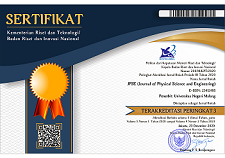Investigation of Optical Properties and Electronic Transfer of Temperature-Dependent ZnO Nanocolumnars Grown by DC Sputtering
Abstract
The morphology of zinc oxide (ZnO) can determine the distribution of defects in the system, which plays an important role in determining its optical and electronic properties. Here, we investigate the optical and electronic transfer properties of different ZnO surface morphologies. ZnO nanocolumnar was synthesized by direct-current (DC) sputtering followed by annealing using a ratio of T/Tm are 0.15, 0.20, and 0.25. The x-ray diffraction (XRD) results show that an increase in annealing temperature causes an increase in crystal size accompanied by a decrease in lattice strain. Furthermore, the surface morphology of the sample changed with increasing annealing temperature treatment, following the structural zone model. The optical and electronic transfer properties of the samples were investigated in three regions; region 1 (T/Tm is 0.15), region 2 (T/Tm is 0.20), and region 3 (T/Tm is 0.25) using optical modeling. The highest surface electronic transfer was noted in region 2, which is indicated by the highest surface energy loss function (SELF). This research can provide a good understanding in designing optoelectronic systems based on their morphological features.
Keywords
Full Text:
PDFReferences
M. Ahmadi, M. Abrari, and M. Ghanaatshoar, “An all-sputtered photovoltaic ultraviolet photodetector based on co-doped CuCrO2 and Al-doped ZnO heterojunction,” Sci. Rep., vol. 11, no. 1, p. 18694, Dec. 2021, doi: 10.1038/s41598-021-98273-5.
A. Wibowo et al., “ZnO nanostructured materials for emerging solar cell applications,” RSC Adv., vol. 10, no. 70, pp. 42838–42859, Nov. 2020, doi: 10.1039/D0RA07689A.
S. Agrohiya et al., “Fabrication of n-TiO2/p-Si photo-diodes for self-powered fast ultraviolet photodetectors,” Silicon, May 2022, doi: 10.1007/s12633-022-01913-2.
Z. Li, Z. Li, C. Zuo, and X. Fang, “Application of nanostructured TiO2 in UV photodetectors: A review,” Adv. Mater., vol. 34, no. 28, p. 2109083, Jul. 2022, doi: 10.1002/adma.202109083.
N. Mufti et al., “Morphological modification and analysis of ZnO nanorods and their optical properties and polarization,” Scanning, vol. 2018, pp. 1–8, Nov. 2018, doi: 10.1155/2018/6545803.
Y. N. Hendri, R. Kurniawan, K. Takase, and Y. Darma, “Origin of ferroelectricity in carbon-doped ZnO nanocolumnars: Experimental and density-functional studies,” Ceram. Int., vol. 48, no. 2, pp. 2038–2044, Jan. 2022, doi: 10.1016/j.ceramint.2021.09.289.
B. Z. Farzin, M. Parhizkar, H. Bidadi, and F. Abbasi, “ZnO nanoparticles and polyaniline blend as an active layer for bulk heterojunction solar cell applications,” J. Mater. Sci.: Mater. Electron., vol. 29, no. 21, pp. 18128–18135, Nov. 2018, doi: 10.1007/s10854-018-9924-0.
C. Liu, C. Xiao, and W. Li, “Zinc oxide nanoparticles as electron transporting interlayer in organic solar cells,” J. Mater. Chem. C, vol. 9, no. 40, pp. 14093–14114, Sep. 2021, doi: 10.1039/D1TC03434K.
I. Ullah et al., “Enhanced efficiency of organic solar cells by using ZnO as an electron-transport layer,” Mater. Res. Express, vol. 4, no. 12, p. 125505, Dec. 2017, doi: 10.1088/2053-1591/aa9dc9.
A. A. Fibriyanti et al., “Improved solar cell and photoresponse performance of CH3NH3PbI3 perovskite with ZnO nanorods,” IOP Conf. Ser.: Mater. Sci. Eng., vol. 515, p. 012089, Apr. 2019, doi: 10.1088/1757-899X/515/1/012089.
I. B. Elkamel, N. Hamdaoui, A. Mezni, and R. Ajjel, “Photoconduction, dielectric and photoluminescence properties of Cu2+: ZnO nanoparticles elaborated by a polyol method,” Ph. Transit., vol. 93, no. 4, pp. 388–406, Mar. 2020, doi: 10.1080/01411594.2020.1734201.
P. Raizada, A. Sudhaik, and P. Singh, “Photocatalytic water decontamination using graphene and ZnO coupled photocatalysts: A review,” Mater. Sci. Energy Technol., vol. 2, no. 3, pp. 509–525, Dec. 2019, doi: 10.1016/j.mset.2019.04.007.
H. Pujiarti et al., “Performance of dye sensitized solar cells (DSSCs) with ZnO nanorod electrode in different seed solution,” JPSE (J. Phys. Sci. Eng.), vol. 6, no. 2, pp. 77–82, Jul. 2021, doi: 10.17977/um024v6i22021p077.
Y. N. Hendri, Y. Rati, R. Marlina, R. Kurniawan, and Y. Darma, “Polarization behavior of seedless ZnO nanocolumnars grown by DC-unbalanced magnetron sputtering,” Ceram. Int., vol. 48, no. 20, pp. 30218–30223, Oct. 2022, doi: 10.1016/j.ceramint.2022.06.294.
B. A. Movchan and A. V. Demchishin, “Structure and properties of thick condensates of nickel, titanium, tungsten, aluminum oxides, and zirconium dioxide in vacuum,” Fiz. Metal. Metalloved., vol. 28, pp. 653–660, Oct. 1969. [Online]. Available: https://www.osti.gov/biblio/4181669.
J. A. Thornton, “Structure-zone models of thin films,” in 31st Annu. Tech. Symp. Opt. Optoelectron. Appl. Sci. Eng., in Modeling of Optical Thin Films, vol. 821, pp. 95–105, Feb. 1988, doi: 10.1117/12.941846.
P. B. Barna and M. Adamik, “Fundamental structure forming phenomena of polycrystalline films and the structure zone models,” Thin Solid Films, vol. 317, no. 1–2, pp. 27–33, Apr. 1998, doi: 10.1016/S0040-6090(97)00503-8.
R. Kurniawan et al., “Polarization behavior of zinc oxide thin films studied by temperature dependent spectroscopic ellipsometry,” Opt. Mater. Express, vol. 7, no. 11, pp. 3902–3908, Nov. 2017, doi: 10.1364/OME.7.003902.
P. P. Das et al., “Redistribution of native defects and photoconductivity in ZnO under pressure,” RSC Adv., vol. 9, no. 8, pp. 4303–4313, Feb. 2019, doi: 10.1039/C8RA10219H.
M. Zhang et al., “Controlled formation of native defects in ultrapure ZnO for the assignment of green emissions to oxygen vacancies,” J. Phys. Chem. C, vol. 124, no. 23, pp. 12696–12704, Jun. 2020, doi: 10.1021/acs.jpcc.0c01078.
G. L. Tan, L. K. DeNoyer, R. H. French, M. J. Guittet, and M. Gautier-Soyer, “Kramers–Kronig transform for the surface energy loss function,” J. Electron Spectros. Relat. Phenomena, vol. 142, no. 2, pp. 97–103, Feb. 2005, doi: 10.1016/j.elspec.2004.09.002.
J. Gong, R. Dai, Z. Wang, and Z. Zhang, “Thickness dispersion of surface plasmon of Ag nano-thin films: Determination by ellipsometry iterated with transmittance method,” Sci. Rep., vol. 5, no. 1, p. 9279, Aug. 2015, doi: 10.1038/srep09279.
Copyright (c) 2022 Robi Kurniawan, Intan Salsabila Mauludina Sari, Isnaini Yulianingtyas, Joyuhan Putra Setyawan, Ibrahim Nur Afrizal Dahlan M., Resti Marlina, Joko Suwardy

This work is licensed under a Creative Commons Attribution-ShareAlike 4.0 International License.
This work is licensed under a Creative Commons Attribution-ShareAlike 4.0 International License




















